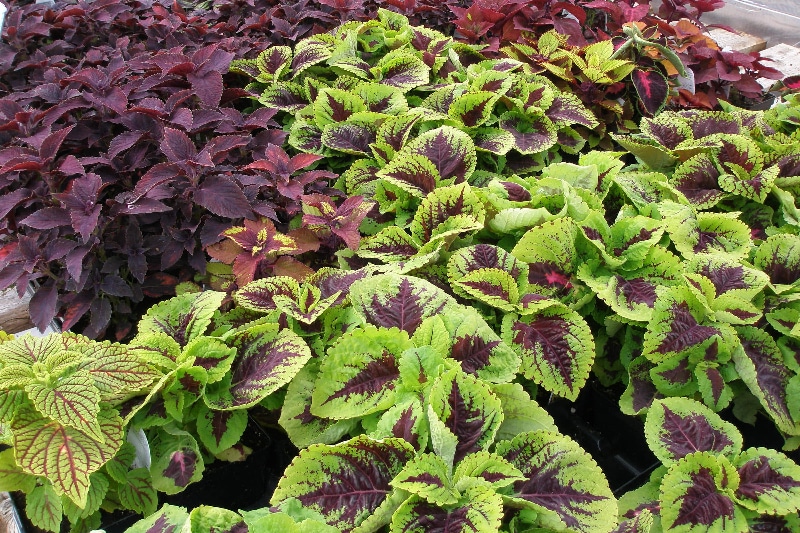If you want to know how to trim coleus correctly, you only need to learn pinching. The technique itself shouldn’t intimidate you, even if you’re a beginner gardener, because you only need to remember a few tips. More so, take comfort with the fact that the University of Florida dubbed coleus as hard to kill.
Ensuring the proper care and maintenance practices of coleus is crucial to keep them happy and to perform better. If the plants stay healthy and stress-free, you can help yourself propagate coleus to your heart’s content. You can also consider keeping the plants in a protective environment, such as the greenhouse if the current climate is challenging.

How To Trim Coleus Correctly
Knowing how to trim coleus properly will benefit the plant’s health and overall look. Remember that coleus is one of those plants that will thrive best if you frequently pinch it back while still growing. In turn, this will encourage better foliage growth compared to leaving the growing stems be.
Besides pinching, you can also help the plants to have an extended blooming period if you remove the faded flowers. This will help rejuvenate the plant and prevent seeding that can affect flower development during the season. However, it’s important to note that some varieties don’t require these practices to branch and produce flowers.
Pinching
For branching
The only technique that you have to master to learn how to trim coleus is pinching. You can use your thumb and index finger to do this on the stem above a node. Choose one that has an axillary bud and where the leaves meet the stem to encourage branching.
For rejuvenation
You can also continue to pinch your coleus plants’ growing tips if you notice that an area is looking leggy. As mentioned previously, you want to squeeze where an axillary bud is present to ensure that the plant will grow new shoots. Pinch back to a leaf node to rejuvenate spindly growth.
For recovery
Pinching is also useful for the leaves of your coleus plants. If your plant has been infested by pests or is undergoing a disease, you can pinch off the affected leaves to slow down the problem’s progression. Do this practice in addition to the treatment and isolation practices you’re doing for the pests or disease.
For growth
Do you need to pinch the flower spikes of coleus plants? Some gardeners pinch back to a leaf node when they notice these flower spikes. The reason behind this is to prevent seeding and save the plant more energy for growth instead.
Lastly, don’t forget to water your coleus plants every time you pinch them. The soil must always be moist but not soggy to help the plant recover from pinching.
How To Maintain And Care For Coleus
Besides trimming, you must always check your coleus plants’ maintenance practices and conditions to keep them happy and healthy. If you are just starting these plants, you want to start them indoors and wait for the weather to warm up outdoors before transplanting. Perhaps the most significant nemesis of these plants is cold temperature.
Ideal location
You can easily keep coleus in the greenhouse, especially if your area experiences challenging and extreme climates. Choose an area that provides shade and keeps the plants in fertile and well-draining soil. The spacing isn’t a problem with these plants because you can keep them close even in containers.
In general, coleus will be happy somewhere hot and humid. Use these conditions as signs of when to propagate the plant as well. Remember that frost will damage the plants, so any practice like propagation is suitable under warm conditions.
What to do with coleus in winter? Overwintering in the greenhouse is necessary for these tender annuals. You can repot them or dig up the plants every winter to protect them from the cold temperatures.
Water and fertilizer
Like most plants, moist soil is necessary for coleus health. Make the necessary adjustments depending on the climate and location to ensure that you aren’t overwatering or underwatering your plants. You don’t want to keep them in soggy soil, leading to root rot and other diseases.
On the other hand, you can encourage growth in spring and summer by feeding the plants with diluted fertilizer. Doing a soil check would also be helpful to check the nutrients and avoid problems. Remember that overfertilizing can affect the color of the coleus leaves.
Common problems
The great thing about coleus plants is that they are not prone to diseases and pests. However, be mindful of the conditions and their stability to avoid problems like scale, mealybugs, and whiteflies. An unstable, extreme, and fluctuating environment can also lead to mildew and other fungal diseases.
Conclusion
Coleus is generally easy to maintain, but they will benefit from certain practices. For example, if you know how to trim coleus properly, you can reap as many as four benefits. First, pinching your plants’ stems can encourage branching, while pinching the growing tips rejuvenates leggy areas.
On the other hand, you can pinch leaf nodes if they are infested by insects or infected by diseases. You can also pinch the plant’s flower spikes if you want to prevent seeding. This way, the plant saves more energy and continue growing instead.
